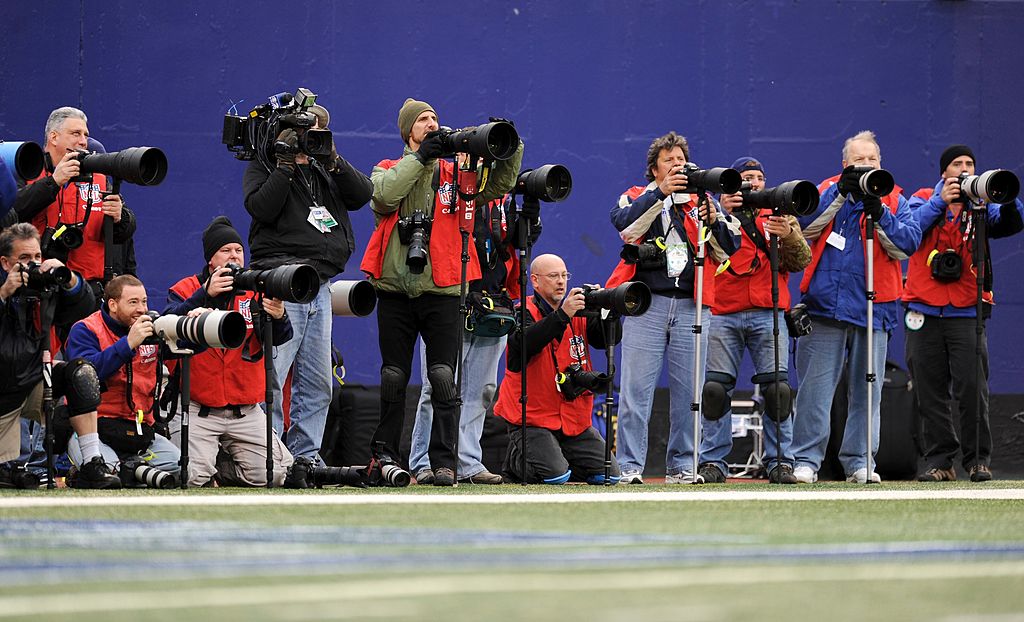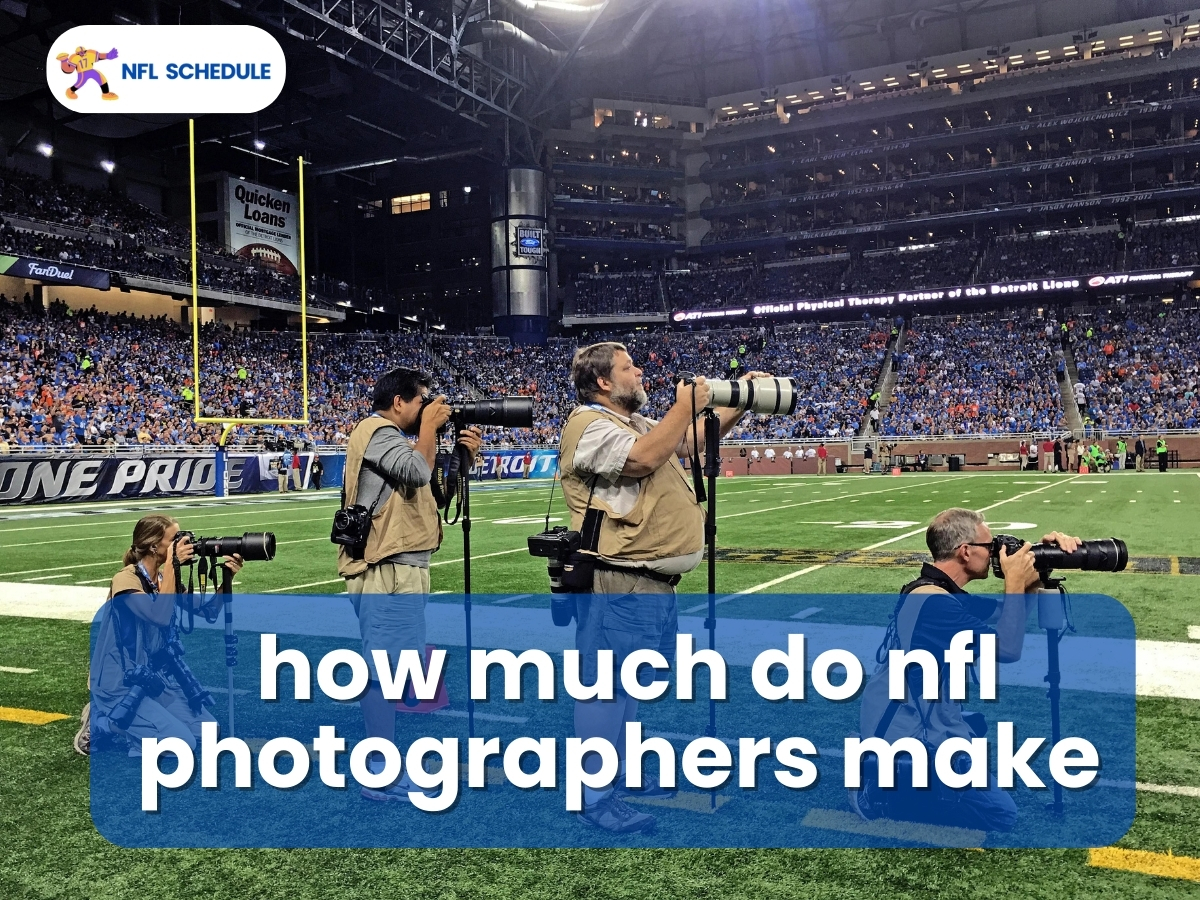The world of professional sports photography, particularly in the NFL, is as dynamic and varied as the game itself. Understanding the salary landscape for NFL photographers requires having a detailed look into various aspects that influence their earnings.
The Earnings Spectrum of NFL Photographers
Average Salaries and Hourly Rates
As of January 2023, the average annual salary of NFL photographers hovers around $39,285, which translates to approximately $18 per hour. This figure represents a broad spectrum, with salaries ranging between $15,500 and $50,000 annually
Factors Influencing Salaries
- Experience: More experienced photographers typically command higher rates due to their established portfolios and reputations for high-quality work
- Geographic Location: Salaries can vary based on where photographers work, with larger metropolitan areas generally offering higher compensation.
- Employer Type: Working for major sports publications or networks often results in higher salaries compared to local media outlets.
- Specialization: Photographers specializing in areas like action shots or portraits may command higher fees.
- Reputation: A strong reputation for reliability and quality work can lead to higher earnings.
Read: Average NFL Referee Salary: Complete Details With Highest Paid Referees
The Role of Cameramen in the NFL
NFL cameramen, responsible for capturing game footage, often earn between $40,000 to $80,000 annually. This range reflects their skill and dedication in bringing the game’s essence to fans worldwide. They benefit from additional income opportunities, such as overtime during playoffs and major events, and often receive perks like health insurance and retirement plans.
Career Pathways and Additional Opportunities
NFL photography careers vary widely, offering different routes and earning potentials.
Types of NFL Photographers

- Team Photographers: Affiliated with specific NFL teams, capturing games, practices, and events. Their income is generally consistent but might not match the levels of freelancers selling to multiple outlets.
- Sideline Photographers: Hired by media outlets or agencies, focusing on action shots during games. Earnings vary based on experience and reputation.
- Portrait Photographers: Specializing in player portraits, often on a contract basis with significant fees, especially for promotional uses.
- Event Photographers: Covering various NFL events with earnings dependent on the event and client.
- Freelance Photographers: With diverse income potential, freelancers sell photos to various clients, including media, sponsors, and the NFL. However, their earnings can be unpredictable.
Earning Breakdown by Job Type
- Team Photographers: Regular salaries ranging from $40,000 to $80,000 or more per year.
- Sideline Photographers: Earning about $200 to $500 per game, with potential for higher rates for well-known photographers.
- Portrait Photographers: Sessions can bring in $1,000 to $5,000, varying based on the player’s profile and photo usage.
- Event Photographers: Typically paid per event, with rates from $100 to $500 or more.
- Freelance Photographers: Earnings from $100 to $500 per image for editorial use, with higher rates for exclusive or high-demand shots. Licensing rights sales can also boost income.
Additional Income Sources
- Merchandise Sales: Selling prints and merchandise featuring their images.
- Sponsorships: Gaining sponsorships from camera equipment manufacturers or related brands.
- Workshops and Teaching: Sharing skills through workshops or teaching roles.
In the competitive realm of NFL photography, success hinges not just on skill but also on understanding industry dynamics and leveraging opportunities. This article further explores the nuances of NFL photographers’ salaries, the skills required to excel in this field, and the various avenues for career advancement.
Key Skills and Qualifications for NFL Photographers
To thrive in NFL photography, a blend of technical proficiency, artistic flair, and sports knowledge is essential.
- Technical Expertise: Mastery of digital and analog cameras, along with software like Photoshop and Lightroom, is crucial.
- Sports Knowledge: A deep understanding of football enhances the ability to capture crucial moments and understand game dynamics.
- Creativity and Storytelling: Successful NFL photographers create narratives that resonate with audiences through their images.
- Physical Agility: Photographers must be able to navigate the dynamic environment of football games, often under challenging conditions.
- Communication and Collaboration: Working closely with a team, including directors and producers, is part of delivering compelling visuals.
Salary Trends and Future Prospects
Recent trends suggest modest increases in NFL photographers’ salaries, reflecting broader economic conditions and the evolving media landscape. The Bureau of Labor Statistics reported an increase in median annual wages for photographers from $36,280 in 2012 to $38,470 in 2016. Although there was a decline during the COVID-19 pandemic, recovery signs are evident, and the demand for digital content could further boost salaries.
Read: How Much Do NFL Cheerleaders Get Paid? The Complete Details
The Impact of Location and Market Dynamics
- Photographers in major cities often charge more due to higher living costs, while those in smaller markets may earn less.
- The evolving media landscape, including the rise of digital platforms, offers new opportunities for photographers to showcase their work and reach broader audiences.
Advancing in the Field: Opportunities and Challenges
Career Progression and Specialization
- Photographers can advance their careers by specializing in certain types of photography, such as action shots or portraits, and by building a reputation for excellence in these areas.
- Pursuing roles like senior cameraman or director offers a path for career growth, especially for staff photographers.
Challenges and Adaptability
- The job can be physically demanding and requires working under tight deadlines and in various weather conditions.
- Adapting to technological advancements and changing industry standards is crucial for staying relevant and competitive.
Read: How Much do Waterboys Make in the NFL? Complete Salary Details
Concluding Thoughts
The NFL photography industry is not just about capturing moments; it’s about weaving stories, adapting to evolving conditions, and continuously enhancing skills. While the financial aspects are important, the passion for sports and the drive to excel in visual storytelling are what truly define a successful NFL photographer. This career path offers not only the thrill of being at the heart of sports action but also the opportunity for personal and professional growth.
Frequently Asked Questions
How do you become an NFL photographer?
To become an NFL photographer, gain experience in sports photography by shooting local games, college sports, or smaller leagues. Build a strong portfolio showcasing dynamic sports moments. Networking is key—connect with professionals, attend sports events, and apply for internships with media outlets or NFL teams. A degree in photography or photojournalism is helpful but not mandatory. Seek opportunities with newspapers, magazines, or broadcasters covering the NFL. Familiarity with football and the ability to handle fast-paced environments are essential. Persistence and consistently improving your skills are vital to breaking into this competitive field.
How much do NFL camera operators make?
NFL camera operators typically earn between $42,000 and $75,000 annually, with an average salary of around $56,000. More experienced operators or those working with major networks may earn up to $100,000 per year. Pay depends on the role, employer, and level of expertise. Freelancers might be paid on a per-game or per-project basis, which varies based on the event’s significance and production budget.
Do sports photographers make good money?
Sports photographers earn an average annual salary of $54,000 to $73,000 in the U.S., depending on experience and the level of sports covered. High-profile photographers may earn more.

